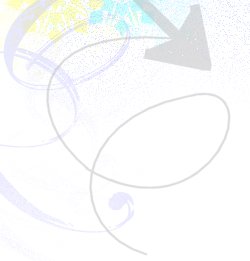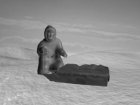 Inuit people live in near the Arctic, which includes area northeast of Russia, northern Canada, and some parts of Greenland. Maquinna lives in the Nunavut area with his family and friends.
Inuit people live in near the Arctic, which includes area northeast of Russia, northern Canada, and some parts of Greenland. Maquinna lives in the Nunavut area with his family and friends.
In the summer, they all lived on land and hunt mostly caribous to survive. When winter draws near, Maquinna's wife Naira would start making clothing out of caribou skin. To respect the animals, the Inuit kept things taken from land animals and sea animals separate from each other. Thus, Naira must finish the caribou clothing on land and not on sea ice. Naira would make parkas, pants, mittens and boots from caribou skin for Maquinna to use for the hunt.
When the sea freezes into thick sheets of ice, Maquinna's tribe will all move out to the sea ice so that they can hunt seals throughout the winter. They use sleds to move their luggage across the sea. Pulling the sled by hand is difficult in the cold weather, and some people will have a team of dogs to pull the sled instead. Maquinna only has one dog so he didn't have that luxury, but he has been doing this every year so he is used to enduring this long walk across the sea ice with his sled behind him.
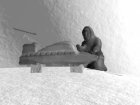 Once they find a place where the ice below them is thick and there are enough snow to build igloos, they all set up their camps together. They all share and help each other, since collaboration is important if they are all to survive the bitter winter.
Once they find a place where the ice below them is thick and there are enough snow to build igloos, they all set up their camps together. They all share and help each other, since collaboration is important if they are all to survive the bitter winter.
Everyday at dawn, Maquinna and his fellow hunters would head out to look for seals. Before leaving, Maquinna would check if he has all his supplies: a harpoon with a detachable harpoon head, sealskin rope, knife and a pouch made with seal flipper to hold drinking water. Naira has sewn teeth from a seal he hunted before on his coat to serve as good luck charms. Maquinna also took a sled with him so he could use it to transport the seal once he caught one, but sometimes he would leave the sled at the camp and just drag the seal behind him without a sled if he catches one. The hunters brought a few dogs with them to help them to locate the seal.
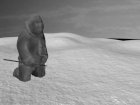 As they look for an area where they think seals can be found, Maquinna keep an eye on the sky to ensure the weather will stay clear; they wouldn't want to be caught in the middle of a storm. He also watch the ice carefully to check for signs of aglu, i.e. breathing hole for seals. Since seals remain in the water for the winter, they create a network of holes on ice which allows them to reach the surface and breathe. Hunters take advantage of this and will watch these agluit to find seal.
As they look for an area where they think seals can be found, Maquinna keep an eye on the sky to ensure the weather will stay clear; they wouldn't want to be caught in the middle of a storm. He also watch the ice carefully to check for signs of aglu, i.e. breathing hole for seals. Since seals remain in the water for the winter, they create a network of holes on ice which allows them to reach the surface and breathe. Hunters take advantage of this and will watch these agluit to find seal.
Maquinna's dog suddenly barks at Maquinna to get his attention; it has found an aglu. Upon examining the area further, Maquinna find that there are quite a few aguit that were recently used by seals. They decided to try hunting for seals here. Each of them picked an aglu to watch over.
Maquinna positioned himself above the aglu and waits for a seal to surface. He stands on a piece of caribou hide that he brought with him to prevent his feet from making sounds. After a long while, there is still no signs of seal, but Maquinna and the others continue to wait silently. Seal hunting requires a lot of patience; sometimes they can wait for an entire day and get nothing in return. But they will not give up, for the entire camp is depending on them to bring in a seal for food.
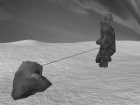 Suddenly, Maquinna hears the sound of water rippling below him; a seal is coming up for air. The moment he hears the seal surfacing to take a breath, he strike his harpoon swiftly down the aglu. The harpoon head pierce into the skin of the seal. Maquinna pulls the harpoon back to retrieve the handle, then tugs the sealskin rope that is tied to the harpoon head so that the head will anchor itself beneath the seal's skin. Maquinna breaks open the aglu more with his harpoon handle so that he has room to pull the seal up. The seal struggles hard, and when Maquinna finally get it to the surface, he strike the seal hard on the head to end its life.
Suddenly, Maquinna hears the sound of water rippling below him; a seal is coming up for air. The moment he hears the seal surfacing to take a breath, he strike his harpoon swiftly down the aglu. The harpoon head pierce into the skin of the seal. Maquinna pulls the harpoon back to retrieve the handle, then tugs the sealskin rope that is tied to the harpoon head so that the head will anchor itself beneath the seal's skin. Maquinna breaks open the aglu more with his harpoon handle so that he has room to pull the seal up. The seal struggles hard, and when Maquinna finally get it to the surface, he strike the seal hard on the head to end its life.
The rest of the hunters gather around Maquinna and rejoice at the catch. Maquinna takes his knife to cut the seal; it was customary for the hunters to get the first taste of the seal. Maquinna slice the belly open to remove its liver; others kneel around him and watch in silence to pay homage to the seal. Maquinna then divided the liver and they all ate together. He then seal the open cut with a bone needle so that the blood and organs will stay inside the seal.
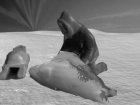 Since Maquinna caught the seal, he is the one who will drag it back to camp. Naira, who was waiting for her husband's return in their igloo, is happy to see him return with a catch. She immediately put some ice in her mouth to melt it, then feeds the water to the dead seal's mouth. This was done as a sign of respect for the seal. Maquinna places the harpoon head that he caught the seal with next to a lamp, since the Inuit believed that the soul of the seal lies in the harpoon head that kills it, and thus they should ensure the soul of the seal stays warm through the night.
Since Maquinna caught the seal, he is the one who will drag it back to camp. Naira, who was waiting for her husband's return in their igloo, is happy to see him return with a catch. She immediately put some ice in her mouth to melt it, then feeds the water to the dead seal's mouth. This was done as a sign of respect for the seal. Maquinna places the harpoon head that he caught the seal with next to a lamp, since the Inuit believed that the soul of the seal lies in the harpoon head that kills it, and thus they should ensure the soul of the seal stays warm through the night.
Naira cuts open the seal and begin to divide it up to portions for distribution. Certain parts are given to certain people; Naira would give the fleshy tail-end parts to the men while giving the parts with more bones to the women. The delicate seal heart and the seal broth are divided amongst everyone. The fat is also divided to each household so that everyone can use it to make fuel for lamps. Every part of the seal is used and shared in the camp.
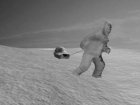 After everyone ate, Naira and Maquinna return to their igloo. Naira started pounding the seal fat to turn it into oil for the lamp. She also plans to make some sealskin boots for Maquinna since they would be waterproof, which is better than the caribou boots. Maquinna checks his equipment to make sure he is ready to hunt again tomorrow. He hopes they could catch more than one seal tomorrow so they could have a bigger and better feast.
After everyone ate, Naira and Maquinna return to their igloo. Naira started pounding the seal fat to turn it into oil for the lamp. She also plans to make some sealskin boots for Maquinna since they would be waterproof, which is better than the caribou boots. Maquinna checks his equipment to make sure he is ready to hunt again tomorrow. He hopes they could catch more than one seal tomorrow so they could have a bigger and better feast.

